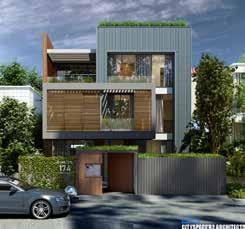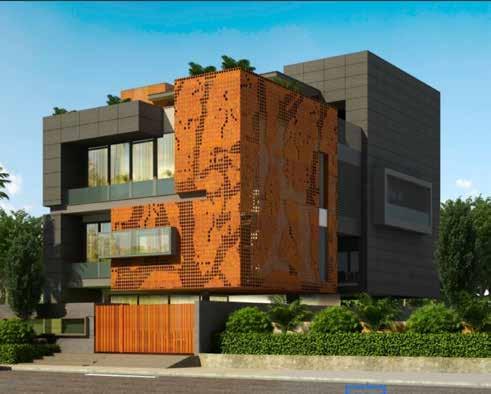
5 minute read
Metal Façades Ar. Sumit Dhawan, Founder & Principal Architect, Cityspace '82 Architects
METAL FAÇADES
Façades determine visual identity, character and expression of architecture. The design and enchanting exteriors of a building impart a character to it and is a huge parameter for building performance. Building façades lie at the convergence of the outward and inward environment, forming an integral part of the building. They are the most difficult to design since
Advertisement
the perception of iconic and technologically advanced façades is changing frequently. Besides technology, materials like metal, glass, concrete etc., used for the building skin are an integral yet singular aspect of the façade design. It is often seen that whenever an architect is talking about metal in façade, it is always correlated with commercial or institutional architecture and few of the examples which will come to our mind will be the Guggenheim Museum Bilbao, designed by the well-known architect Frank O Gehry, done in titanium; Riverside Museum by Zaha Hadid or maybe the Sage Gateshead in UK by Norman Foster. But no residence done in metal will come to our mind and if the same is proposed in a residence by an architect, most of the clients’ apprehension will be, “I hope it won’t look ‘commercial’”. The façade combines attributes



The distinctive combination of seamless zinc panels with aluminium louvers and leather finished stone leaves an everlasting impression
The convergence of the building with the sky was achieved by the use of Fibre Optics lighting integrated with the white painted wall on the front façade

of both appearance as well as superior performance in a manner unlike any other building system. I emphasise on the use of metal façades in residences due to the extremely beneficial properties of metal. Aesthetically speaking, metal offers a unique modern rhythmic aesthetic to compliment any building. Easily bent and configured to the specific design, it can be used as a lightweight decorative element or as a structural component in buildings. Metal roofs and wall panels can also be curved to create a unique and dynamic building appearance, hence amplifying its versatility. Not only can metal withstand harsh weather environments, it can also resource depletion due to its recyclability. Being an eco-friendly entity, metal minimizes energy use, promotes sustainability, and invites innovation and creativity in terms of design. The concept is fast catching up in India but the changes go beyond skin deep alterations or a facelift. Apart from aesthetics, they also offer better functions.
Looking at the materials used for metal façades, let’s see how metal cladding encompasses a plethora
The bold corten steel look imitated in aluminium, grants the façade a distinctive character

The corner cube composed out of zinc panelling serves as the showstopper for this façade

Amalgamating customised zinc panels and pigmento brown, and the wooden frames used for glazing, glass and metal railings gives the structure a sense of harmony and subtlety


of different materials, each with its own unique strengths and weaknesses. The choice of material will be influenced by a number of project-specific factors, including desired aesthetic, climatic conditions, chosen structural system, the nature of adjacent materials and the construction budget. The most common material options for metal cladding are galvanized steel, aluminium, stainless steel, zinc, copper, titanium etc. Designers are researching and experimenting with new and complex façade and fenestration technologies. Along with the materials that furnish the look and feel of a building, technologies applied to façades are also changing. Investing in technologies like BIM allows designers distil options down to a The stunning composition of zinc side-lit panels give the facade a dramatic look during the day as well as night set of criteria that meet the aesthetic ambitions of the project and its tactical requirements, ensuring that these are met with optimised environmental parameters. There has been a slow but very perceptible shift from the use of traditional masonry towards the use of compelling automation in façade and fenestration. Motorized shades; switchable windows


An ideological retreat with robust attributes and voluminous lightfilled living spaces
that modulate daylight and solar


A vibrant terrace garden
heat transmissions; model predictive controls for optimised performance end-user comfort and satisfaction; and acceptance of automated façade systems are the various ways automation is incorporated in façades. These tools enable designers to explore the forms, real-time and derive key insights into the thermal, daylight and solar performance informing decisions pertaining to the building orientation, solar shading, glazing, etc. and also saves the cost. Thus, metal façades combined with the right dose of technology can uplift the exterior of spaces and multiply their utility.


Omitting smaller cubes from the bigger ones provided the building with openings and punctures allowing natural light inside the house

AR. SUMIT DHAWAN
Founder & Principal Architect, Cityspace '82 Architects
ABOUT THE AUTHOR:
Having experience of almost two decades, Ar. Sumit Dhavan has single-handedly nurtured this firm and given it a position where it stands today. His architect father Satish Dhawan worked with CPWD and had a great exposure to the international market. Having said that, he has done projects for politicians, bureaucrats, lawyers, the residence of famous cricketers Yuvraj Singh and Gautam Gambhir, and many more. Also, his work is appreciated by developers whom he has collaborated with including DLF, Ansal Group, Orchid, MGF to name a few.
This elegant facade fabricated in small modules of Pigmento Grey Zinc, with mouldings creating a monolithic impression












